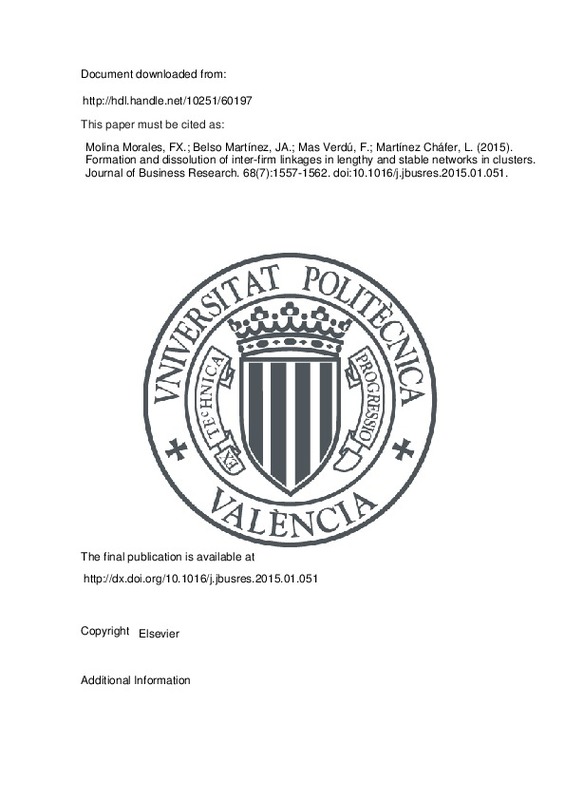JavaScript is disabled for your browser. Some features of this site may not work without it.
Buscar en RiuNet
Listar
Mi cuenta
Estadísticas
Ayuda RiuNet
Admin. UPV
Formation and dissolution of inter-firm linkages in lengthy and stable networks in clusters
Mostrar el registro sencillo del ítem
Ficheros en el ítem
| dc.contributor.author | Molina Morales, F. Xavier
|
es_ES |
| dc.contributor.author | Belso Martínez, José A.
|
es_ES |
| dc.contributor.author | Mas Verdú, Francisco
|
es_ES |
| dc.contributor.author | Martínez Cháfer, Luis
|
es_ES |
| dc.date.accessioned | 2016-01-26T16:37:12Z | |
| dc.date.available | 2016-01-26T16:37:12Z | |
| dc.date.issued | 2015-07 | |
| dc.identifier.issn | 0148-2963 | |
| dc.identifier.uri | http://hdl.handle.net/10251/60197 | |
| dc.description.abstract | [EN] Firms aspire to take advantage of technical and business networks through inter-organizational interactions to improve performance. Consequently, researchers are increasingly focusing on the dynamics and implications of network formation at both local and global levels. The recent research trend does not consider a monotonic effect and simplistic approach to proximity because proximity is a complex multidimensional concept. Using data from a foodstuffs cluster in the Valencian region (Spain) and advanced econometric methods such as Exponential Random Graph Models, this study aims to clarify the detrimental effects and complementarities that may arise among proximity dimensions. After controlling for network endogenous forces and firm characteristics, findings reveal the negative effect of cognitive and institutional proximity dimensions on the creation of linkages in advanced stages of the cluster life cycle. Furthermore, social proximity and geographical proximity favor the formation of inter-firm relationships and reinforce the organizational dimension. | es_ES |
| dc.description.sponsorship | The authors acknowledge the financial support of the Spanish Ministry of Economy and Competitiveness (Research Project Number ECO2012-32663 and Research Project Number ECO2010-2055). | |
| dc.language | Inglés | es_ES |
| dc.publisher | Elsevier | es_ES |
| dc.relation.ispartof | Journal of Business Research | es_ES |
| dc.rights | Reserva de todos los derechos | es_ES |
| dc.subject | Clusters | es_ES |
| dc.subject | Networks | es_ES |
| dc.subject | ERGM | es_ES |
| dc.subject | Social capital | es_ES |
| dc.subject | Proximity | es_ES |
| dc.subject.classification | ECONOMIA APLICADA | es_ES |
| dc.title | Formation and dissolution of inter-firm linkages in lengthy and stable networks in clusters | es_ES |
| dc.type | Artículo | es_ES |
| dc.identifier.doi | 10.1016/j.jbusres.2015.01.051 | |
| dc.relation.projectID | info:eu-repo/grantAgreement/MINECO//ECO2012-32663/ES/EL PAPEL DE LA INDUSTRIA CREATIVA EN LA INNOVACION DE LOS CLUSTERS INDUSTRIALES VALENCIANOS. UNA APROXIMACION DESDE LA PERSPECTIVA DE LAS REDES SOCIALES/ | es_ES |
| dc.relation.projectID | info:eu-repo/grantAgreement/MICINN//ECO2010-20557/ES/LA CONTRIBUCION DE LAS REDES INTERORGANIZACIONALES A LA PERFORMANCE DE LAS EMPRESAS LOCALIZADAS EN LOS DISTRITOS INDUSTRIALES%2FCLUSTERS. UN ANALISIS MULTISECTORIAL DESDE UNA PE/ | |
| dc.rights.accessRights | Abierto | es_ES |
| dc.contributor.affiliation | Universitat Politècnica de València. Departamento de Economía y Ciencias Sociales - Departament d'Economia i Ciències Socials | es_ES |
| dc.description.bibliographicCitation | Molina Morales, FX.; Belso Martínez, JA.; Mas Verdú, F.; Martínez Cháfer, L. (2015). Formation and dissolution of inter-firm linkages in lengthy and stable networks in clusters. Journal of Business Research. 68(7):1557-1562. https://doi.org/10.1016/j.jbusres.2015.01.051 | es_ES |
| dc.description.accrualMethod | S | es_ES |
| dc.relation.publisherversion | http://dx.doi.org/10.1016/j.jbusres.2015.01.051 | es_ES |
| dc.description.upvformatpinicio | 1557 | es_ES |
| dc.description.upvformatpfin | 1562 | es_ES |
| dc.type.version | info:eu-repo/semantics/publishedVersion | es_ES |
| dc.description.volume | 68 | es_ES |
| dc.description.issue | 7 | es_ES |
| dc.relation.senia | 282499 | es_ES |
| dc.contributor.funder | Ministerio de Ciencia e Innovación |







![[Cerrado]](/themes/UPV/images/candado.png)

